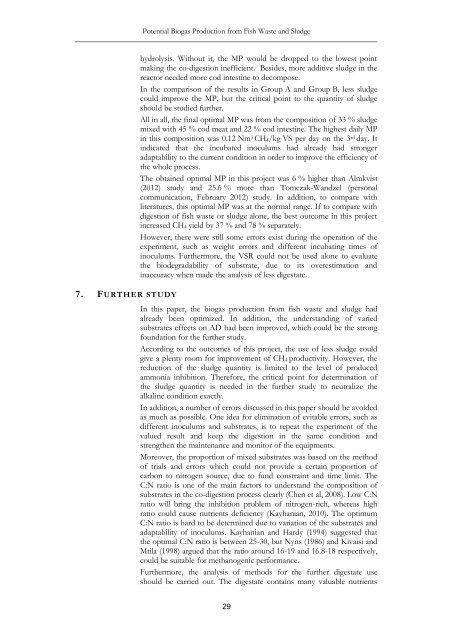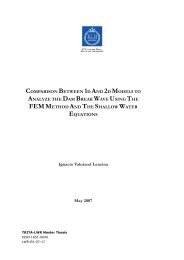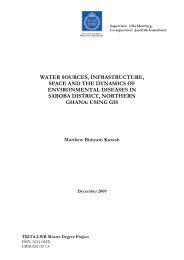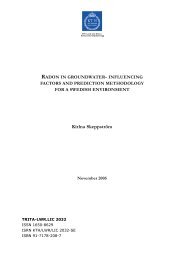POTENTIAL BIOGAS PRODUCTION FROM FISH WASTE AND ...
POTENTIAL BIOGAS PRODUCTION FROM FISH WASTE AND ...
POTENTIAL BIOGAS PRODUCTION FROM FISH WASTE AND ...
Create successful ePaper yourself
Turn your PDF publications into a flip-book with our unique Google optimized e-Paper software.
Potential Biogas Production from Fish Waste and Sludge7. FURTHER STUDYhydrolysis. Without it, the MP would be dropped to the lowest pointmaking the co-digestion inefficient. Besides, more additive sludge in thereactor needed more cod intestine to decompose.In the comparison of the results in Group A and Group B, less sludgecould improve the MP, but the critical point to the quantity of sludgeshould be studied further.All in all, the final optimal MP was from the composition of 33 % sludgemixed with 45 % cod meat and 22 % cod intestine. The highest daily MPin this composition was 0.12 Nm 3 CH 4/kg VS per day on the 3 rd day. Itindicated that the incubated inoculums had already had strongeradaptability to the current condition in order to improve the efficiency ofthe whole process.The obtained optimal MP in this project was 6 % higher than Almkvist(2012) study and 25.6 % more than Tomczak-Wandzel (personalcommunication, February 2012) study. In addition, to compare withliteratures, this optimal MP was at the normal range. If to compare withdigestion of fish waste or sludge alone, the best outcome in this projectincreased CH 4 yield by 37 % and 78 % separately.However, there were still some errors exist during the operation of theexperiment, such as weight errors and different incubating times ofinoculums. Furthermore, the VSR could not be used alone to evaluatethe biodegradability of substrate, due to its overestimation andinaccuracy when made the analysis of less digestate.In this paper, the biogas production from fish waste and sludge hadalready been optimized. In addition, the understanding of variedsubstrates effects on AD had been improved, which could be the strongfoundation for the further study.According to the outcomes of this project, the use of less sludge couldgive a plenty room for improvement of CH 4 productivity. However, thereduction of the sludge quantity is limited to the level of producedammonia inhibition. Therefore, the critical point for determination ofthe sludge quantity is needed in the further study to neutralize thealkaline condition exactly.In addition, a number of errors discussed in this paper should be avoidedas much as possible. One idea for elimination of evitable errors, such asdifferent inoculums and substrates, is to repeat the experiment of thevalued result and keep the digestion in the same condition andstrengthen the maintenance and monitor of the equipments.Moreover, the proportion of mixed substrates was based on the methodof trials and errors which could not provide a certain proportion ofcarbon to nitrogen source, due to fund constraint and time limit. TheC:N ratio is one of the main factors to understand the composition ofsubstrates in the co-digestion process clearly (Chen et al, 2008). Low C:Nratio will bring the inhibition problem of nitrogen-rich, whereas highratio could cause nutrients deficiency (Kayhanian, 2010). The optimumC:N ratio is hard to be determined due to variation of the substrates andadaptability of inoculums. Kayhanian and Hardy (1994) suggested thatthe optimal C:N ratio is between 25-30, but Nyns (1986) and Kivaisi andMtila (1998) argued that the ratio around 16-19 and 16.8-18 respectively,could be suitable for methanogenic performance.Furthermore, the analysis of methods for the further digestate useshould be carried out. The digestate contains many valuable nutrients29
















